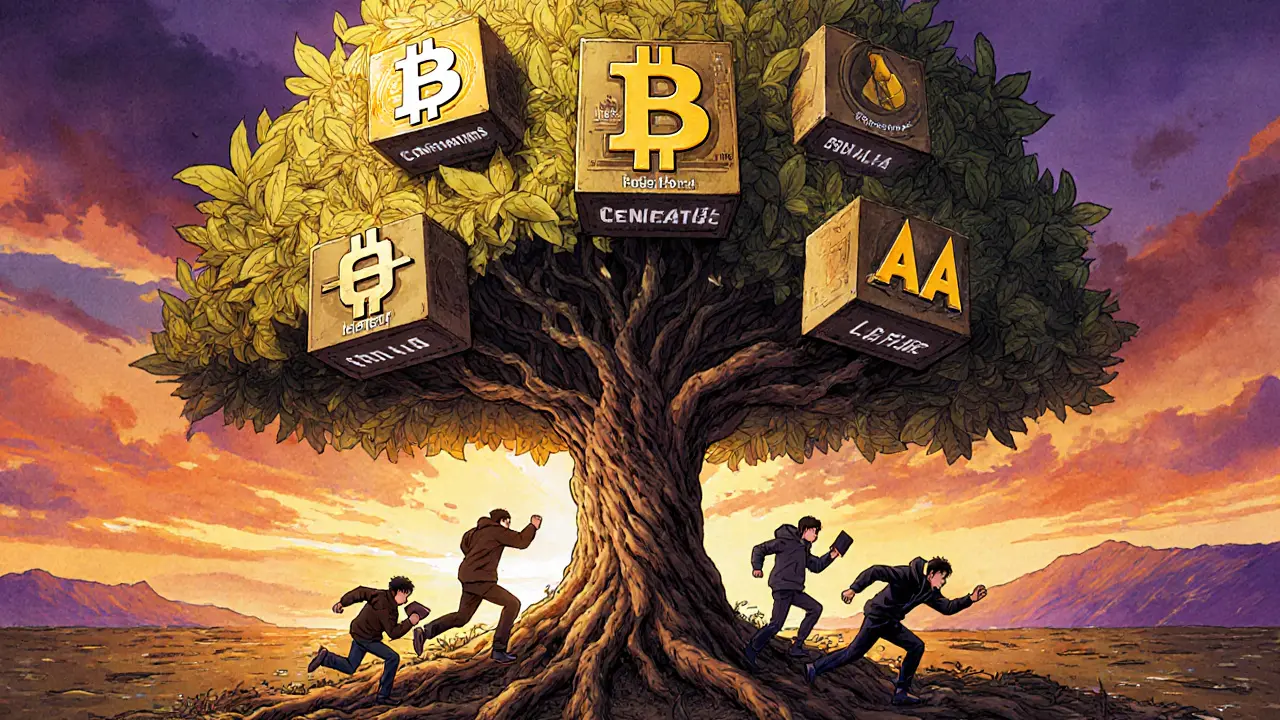Cryptocurrency Confirmation Time Calculator
Ever sent Bitcoin and wondered why it’s still showing as "pending" hours later? Or maybe you paid for something online with Ethereum and got nervous because the seller said "wait for 3 confirmations"? You’re not alone. Cryptocurrency confirmation times aren’t always obvious, and getting them wrong can cost you time, money, or trust.
The truth is, confirmation time isn’t just about waiting. It’s about security. Every time a transaction gets added to a new block on the blockchain, it gets another "confirmation." Each one makes it harder to reverse. But how long does that actually take? And how many do you really need?
What Exactly Is a Cryptocurrency Confirmation?
A confirmation happens when a transaction is included in a block that’s been added to the blockchain. Think of it like this: you hand someone cash. They put it in a locked box and seal it. That’s the first confirmation. Now, five more people come by, each putting their own lock on that same box. By the sixth lock, it’s practically impossible to open without all their keys. That’s what confirmations do - they lock in your transaction across the network.
It’s not the same as block time. Block time is how often a new block is created - like a train schedule. Confirmation time is how long it takes for your transaction to get on one of those trains. If Bitcoin’s block time is 10 minutes, then your transaction gets its first confirmation roughly every 10 minutes. But if the network is busy, it might sit in the waiting room longer before boarding.
Why Do Confirmations Matter?
Without confirmations, anyone could spend the same coins twice - a problem called double-spending. In traditional banking, the bank stops this by keeping a central ledger. In crypto, the network does it by building a chain of blocks that everyone agrees on.
Each confirmation adds another layer of proof that your transaction is real. After one confirmation, it’s likely valid. After six, it’s nearly impossible to undo. That’s why exchanges and merchants care so much about the number. A $5 coffee might only need one confirmation. A $50,000 property sale? They might wait for 10 or more.
For users, this means patience. For businesses, it’s a risk calculation. Too few confirmations? You could lose money to fraud. Too many? Customers leave because payments feel slow.
How Long Do Confirmations Take? By Coin
Not all cryptocurrencies work the same. Block times vary wildly, and so do confirmation speeds.
- Bitcoin (BTC): 10 minutes per block. First confirmation usually takes 10-20 minutes, depending on network load. Six confirmations = about one hour.
- Ethereum (ETH): Around 12-15 seconds per block. First confirmation often under a minute. Six confirmations = 1-2 minutes.
- Litecoin (LTC): 2.5 minutes per block. Six confirmations = 15 minutes.
- Bitcoin Cash (BCH): 10 minutes per block, similar to Bitcoin.
- Cardano (ADA): Around 20 seconds per block. Six confirmations = under 3 minutes.
- Solana (SOL): 400 milliseconds per block. Confirmations happen in seconds.
These are averages. During high traffic - like when a popular NFT drops or Bitcoin surges - even fast chains can backlog. Your transaction might sit in the mempool (the waiting room for unconfirmed transactions) for hours if you didn’t pay enough in fees.
Transaction Fees: The Hidden Speed Dial
Here’s the thing: you control the speed - to a degree. Transaction fees are how you tell miners or validators, "Hey, I want this done fast." Higher fees = higher priority.
Bitcoin wallets usually show fee estimates: "Low," "Medium," "High." Low might take 2+ hours. High? Often under 15 minutes. Ethereum works the same way, but with "gas fees." If you set it too low, your transaction can get stuck for days.
Some wallets let you bump the fee later if it’s stuck - a feature called "Replace-by-Fee" (RBF). Others don’t. Always check your wallet’s settings before sending.
Pro tip: Use a block explorer like Blockchain.com or Etherscan to see current fee levels. You don’t need to overpay. Just pay enough to beat the crowd.

How Many Confirmations Do You Really Need?
There’s no universal rule. It depends on how much you’re sending and how much risk you’re willing to take.
- 0 confirmations (ZeroConf): Used by some merchants for small purchases - like coffee or digital downloads. Risky. Possible to reverse if someone attacks the network. Only safe if you trust the sender or the amount is tiny.
- 1 confirmation: Fine for under $100. Many exchanges allow instant deposits at this level.
- 3 confirmations: The sweet spot for most users. Balances speed and security. Good for $100-$1,000 transactions.
- 6 confirmations: Industry standard for large transfers. Bitcoin exchanges require this for withdrawals. Takes about an hour on BTC.
- 12+ confirmations: Used for high-value transfers, institutional payments, or when security is non-negotiable.
Remember: each confirmation adds exponentially more security. The first one reduces risk by 90%. The sixth makes it 99.99%+ secure. After 10, it’s practically irreversible.
What Is Zero Confirmation (ZeroConf)?
ZeroConf lets you accept payments before they’re confirmed on the blockchain. Sounds risky? It is - but it’s also how some crypto payment processors like BitPay and Coinbase Commerce make online purchases feel as fast as PayPal.
How? They use real-time monitoring of the network. If your transaction looks valid (correct address, sufficient funds, no signs of double-spending), they approve it instantly - even before a miner picks it up. They take on the risk.
It works best for low-value, low-risk transactions. A $20 online game purchase? ZeroConf is fine. A $5,000 laptop? Not so much.
Some users love it. Others avoid it entirely. It’s a trade-off: speed vs. safety.
What Causes Delays?
Five big reasons your transaction is stuck:
- Low fee: The #1 cause. Miners prioritize higher-paying transactions.
- Network congestion: Too many people sending at once. Bitcoin’s mempool can fill up during bull runs.
- Complex transactions: Multi-signature wallets or smart contracts take longer to validate.
- Wallet issues: Some wallets don’t broadcast properly. Try switching to a different one.
- Chain forks or upgrades: Rare, but during hard forks, confirmations can pause temporarily.
If your transaction is stuck, check its status on a block explorer. If it’s been over 24 hours with no confirmation, you might need to cancel and resend with a higher fee - if your wallet supports it.

What Happens If a Transaction Never Confirms?
It doesn’t vanish. It just sits in the mempool until it gets picked up or expires.
Most networks automatically drop unconfirmed transactions after 48-72 hours. Your coins return to your wallet. But if you sent them to the wrong address? Too bad. No one can reverse it.
Always double-check addresses. Use copy-paste, never type manually. And never send to an address you don’t fully trust.
How to Speed Up Confirmations
Here’s what actually works:
- Use a wallet that shows real-time fee suggestions (like Electrum, Trust Wallet, or MetaMask).
- Enable RBF if your wallet supports it - lets you increase the fee later.
- Check current network fees on sites like BitcoinFees.earn.com or EthGasStation.info.
- Avoid sending during known peak times - like weekend crypto rallies or major news events.
- For frequent users, consider using Layer 2 solutions like the Lightning Network (for Bitcoin) or Polygon (for Ethereum). They cut confirmation times to seconds.
There’s no magic trick. It’s simple: pay more, wait less. Or use a faster chain.
Final Advice: When to Wait, When to Move On
For small, everyday transactions - buying a meal, tipping a creator, paying for a subscription - 1-3 confirmations are enough. You’re not risking much.
For anything over $1,000, wait for at least 6. If you’re a merchant, don’t ship goods until you see them. Even if the buyer says "it’s confirmed," wait. Fraudsters love to exploit impatience.
And if you’re sending to an exchange? Always follow their rules. Some require 12 confirmations for Bitcoin. Others ask for 30 on smaller coins. Ignore them at your own risk.
Cryptocurrency is fast - but not instant. Understanding confirmation times isn’t about being technical. It’s about being smart. You don’t need to be a developer to protect your money. Just know when to wait, and when to pay a little more to get there faster.
How long does a Bitcoin confirmation usually take?
A Bitcoin confirmation typically takes 10 to 20 minutes for the first one, since blocks are mined roughly every 10 minutes. But during high network traffic, it can take longer - sometimes over an hour - if the transaction fee is too low. Six confirmations, which most exchanges require, take about an hour under normal conditions.
Why is my crypto transaction still unconfirmed after hours?
The most common reason is a low transaction fee. Miners prioritize transactions with higher fees. If you set it too low, your transaction can sit in the mempool for hours or even days. Check your wallet’s fee settings and consider using a block explorer to see current fee levels. Some wallets let you increase the fee later (RBF), or you may need to cancel and resend.
Is 1 confirmation enough for a crypto payment?
For small amounts under $100, one confirmation is often acceptable, especially if you’re dealing with a trusted party. Many exchanges allow instant deposits at one confirmation. But for anything larger, or if you’re a merchant receiving payment, one confirmation isn’t safe enough. Double-spending attacks are rare but possible before multiple confirmations.
Do all cryptocurrencies have the same confirmation times?
No. Bitcoin takes about 10 minutes per block. Ethereum is much faster at 12-15 seconds. Solana and Cardano can confirm in under a minute. Litecoin is around 2.5 minutes. The speed depends on how often the network creates new blocks. Always check the block time of the specific coin you’re using.
What is Zero Confirmation (ZeroConf) and is it safe?
ZeroConf means accepting a payment before it’s added to a block. It’s fast - ideal for coffee shops or digital goods - but risky. It relies on the payment processor detecting fraud in real time. For small, low-value transactions, it’s widely used and generally safe. For large payments, never rely on ZeroConf alone. Always wait for at least 3-6 confirmations.
How many confirmations are needed for a large crypto transfer?
For large transfers - say, over $10,000 - most exchanges and institutions require at least 6 confirmations. Some, especially for high-value assets or institutional clients, wait for 12 or even 60 confirmations. Each confirmation adds another layer of security. On Bitcoin, 6 confirmations take about an hour. For Ethereum, it’s under 2 minutes. The more valuable the transaction, the more confirmations you should wait for.


Post Comments (1)
Let me break this down like I’m explaining it to my 72-year-old uncle who still thinks crypto is a pyramid scheme: confirmations aren’t magic-they’re math. Each one is a cryptographic seal stamped by a distributed network of nodes. The first confirms it’s not a double-spend; the sixth makes it statistically impossible to reverse without controlling 51% of the network’s hash power. That’s not hype-that’s proof-of-work in action. And yes, if you’re sending $500 to a stranger on eBay, you’re an idiot if you accept one confirmation. But for a $3 coffee? ZeroConf is fine. Don’t overthink it, but don’t be reckless either.